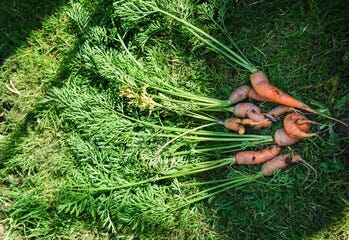- Overcrowded seedlings compete for resources, leading to stunted, misshapen root vegetables.
- Wildlife repellents containing capsaicin do not harm pollinators like bees.
- Brown or orange arborvitae will not recover and need replacement.
Question: For the past two years, I have planted root crops including carrots, radishes and beets, and most of these vegetables are small, twisted and misshaped when I harvest them. I have tried different varieties with nearly the same result. What causes this?
Answer: There could be a few potential causes for this fairly common problem. Overcrowding seedlings is the most common cause of this problem, particularly with carrots, onions and radishes.
It’s fine to seed these crops thickly to assure even spacing in the row, but you should thin out seedlings after germination as overcrowded seedlings will compete for water, nutrients and space, which often causes stunted or distorted growth.
Other possible causes include compacted or heavy soils when growing in the ground, or a too shallow raised bed or container when growing in beds or containers. Whatever the cause, these “ugly vegetables” are perfectly edible.

Q: I have terrible deer pressure in my landscape, and some rabbit damage as well, so I continually apply wildlife repellents to many of my plants. I have a lot of pollinator plants to attract bees and butterflies and I’m wondering if these repellents are harmful to bees and other pollinators.
A: Most wildlife repellents contain capsaicin, which is the compound that makes peppers taste hot. Research has been done to determine whether capsaicin is harmful to bees and the conclusions have been that it does not pose a risk to bees or other pollinators.
Some wildlife repellents contain predator urine, particularly coyote urine, which repels deer. I have not seen any research which explored whether urine-based repellents pose any risk to bees and other pollinators.
Q: We planted eight arborvitae last summer as a living fence. This winter and early spring, we noticed that three of these shrubs had turned to brown and now orange. What causes this and will the affected plants recover?

A: Arborvitae is a shrub which is widely used as a hedge, screen or living fence in the home landscape. I have noticed a large number of brown and orange arborvitae around the Greater Columbus, Ohio this spring.
While there are a couple of different insects which attack arborvitae — most notably bagworm and scale — damage from these insects typically appears after a couple of seasons of infestation. Bags of the bagworm are also pretty noticeable hanging from affected branches of arborvitae.
My guess is that many of these plants were killed by a lack of moisture associated with the droughty conditions which we experienced throughout much of Ohio last summer.
Arborvitaes need an even amount of soil moisture to grow and thrive. They really suffer when put under drought stress. As a general rule, newly transplanted shrubs need to be watered frequently during the first season, and this is particularly true when precipitation is sparse.
Arborvitaes which have turned completely brown or orange will not recover and will need to be replaced, and watered well!
Editor’s note: Throughout the growing season, Mike Hogan, OSU Extension educator for Agriculture and Natural Resources in Franklin County, will answer gardening and home landscape questions submitted by Columbus Dispatch readers. Send your questions to hogan.1@osu.edu.







